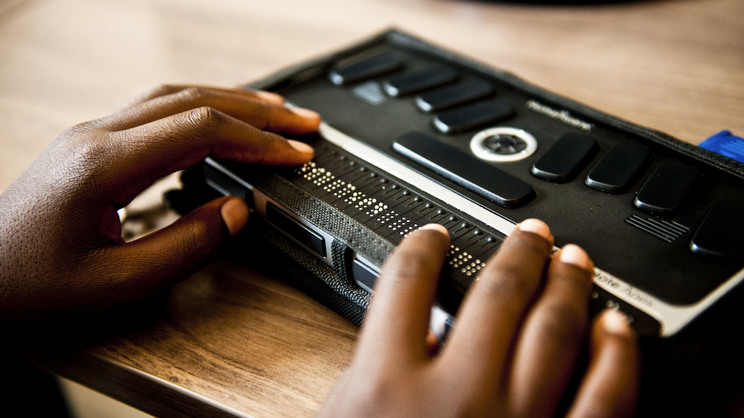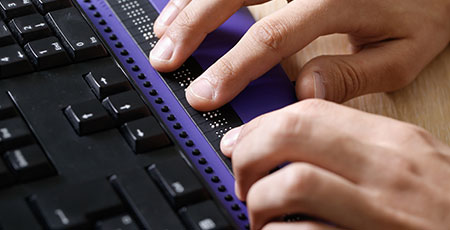Discover Innovative Devices Made for the Aesthetically Impaired
The development of innovative tools for the visually impaired stands for a significant improvement in access and self-reliance. Technologies such as clever glasses with AI capacities and mobile applications made to provide acoustic summaries are improving day-to-day experiences for customers.
Smart Glasses for Navigating
Smart glasses designed for navigation are reinventing the way aesthetically impaired individuals connect with their atmosphere. These advanced devices use a combination of video camera modern technology, expert system, and acoustic feedback to offer real-time details concerning surroundings. By employing challenge discovery systems, wise glasses can inform users to potential dangers, making it possible for much safer movement in both unfamiliar and acquainted setups.
The combination of GPS modern technology better enhances navigating abilities, enabling individuals to obtain auditory directions as they move. This hands-free approach not just fosters freedom but additionally empowers aesthetically damaged people to browse urban landscapes with enhanced confidence. Furthermore, numerous wise glasses are furnished with features that identify spots and road indications, giving contextual information that improves the customer experience.
Furthermore, the advancement of these gadgets is constantly progressing, with business working to improve the accuracy of things recognition and broaden the series of navigational attributes. As wise glasses become much more accessible and budget friendly, they hold the potential to dramatically change life for visually impaired individuals. Inevitably, these ingenious devices stand for a critical action toward inclusivity, offering boosted wheelchair and a greater sense of autonomy for individuals browsing the world around them.

Mobile Apps for Daily Living
Just how can mobile applications enhance the every day lives of aesthetically impaired people? Mobile applications are revolutionizing the way aesthetically impaired individuals navigate their settings, handle daily jobs, and accessibility info. These applications supply vital support through numerous capabilities, promoting self-reliance and boosting lifestyle.
Several cutting-edge mobile applications are designed especially for daily living. Applications like Be My Eyes attach visually damaged individuals with sighted volunteers via video clip calls, permitting them to get real-time support with tasks such as checking out labels or browsing strange areas. Similarly, Seeing AI, developed by Microsoft, uses man-made intelligence to describe environments, read message, and recognize items, properly transforming a smart device into an effective device for daily assistance.
Additionally, navigating apps tailored for the aesthetically impaired, such as Aira and BlindSquare, supply audio-based directions and ecological details, allowing individuals to traverse their environments securely and confidently. Beyond navigating and immediate assistance, mobile applications also support organization and job administration, with features that help users establish suggestions, develop order of business, and track visits. In recap, mobile applications act as indispensable resources, equipping visually damaged individuals to lead even more independent and satisfying lives.
Wearable Technologies for Support
Empowerment through technology is increasingly apparent in the world of wearable tools made to aid visually damaged individuals. These cutting-edge tools integrate perfectly right into life, improving navigation and offering essential feedback to individuals. Wise glasses outfitted with electronic cameras can review and identify faces message aloud, permitting customers to communicate even more confidently in expert and social setups.
Another notable advancement is the use of haptic comments systems in wearable tools. These systems use vibrations or other tactile signals to communicate info concerning the individual's setting, such as challenges or changes in terrain, improving wheelchair and safety and security. Wearable technologies also include wristbands that connect to smart devices, signaling users to notices via subtle resonances, therefore enhancing connectivity without reliance on visual cues.
As these modern technologies continue to progress, they are not only enhancing self-reliance for visually impaired people yet likewise fostering a greater sense of inclusion in culture. By bridging the void between difficulties dealt with in everyday OCR devices for the blind living and the possibility for freedom, wearable technologies function as critical devices in the mission for equal rights and empowerment for those with visual disabilities.
Sound Summary Tools
Sound summary tools play an essential function in enhancing access for aesthetically damaged people, giving them with the capability to engage with visual media. AI-powered visual aids. These tools provide narrated summaries of vital visual elements in films, tv programs, and live efficiencies, guaranteeing that customers can totally understand the context and feelings communicated through visuals
Sound summary can be integrated right into numerous platforms, including streaming solutions, cinema screenings, and live cinema. Lots of preferred streaming services currently consist of audio description as an ease of access feature, allowing customers to choose it easily. Along with conventional media, specialized apps additionally exist, providing audio descriptions for art exhibitions, galleries, and other social occasions.
The efficiency of audio description hinges on the ability of the narrators, who should share visual details succinctly without detracting from the initial audio. Advancements in this field are additionally leading the way for even more tailored experiences, where individuals can adjust the level of detail and pacing according to their choices.
Braille Innovations and Tools
Braille tools and innovations have significantly changed the means aesthetically damaged people interact with message and details. Modern developments have brought about the growth of flexible tools that enhance proficiency and independence amongst individuals. Especially, Braille present modern technologies have actually evolved, enabling vibrant reading experiences. These gadgets convert electronic text right into Braille, making it possible for users to access a huge array of details on tablets, computers, and mobile phones.
Furthermore, portable Braille notetakers combine traditional Braille input with contemporary performances, promoting note-taking, scheduling, and paper editing on the move. AI-powered visual aids. These portable devices frequently include text-to-speech capabilities, connecting the gap between Braille and acoustic info
Additionally, innovative Braille printers have emerged, enabling customers to create Braille tags, files, and instructional products successfully. This accessibility promotes better engagement in expert and instructional atmospheres, eventually promoting inclusivity.
In addition, research study right into wise Braille modern technologies continues to broaden. Devices that integrate expert system are being discovered to provide real-time navigation help and contextual info, improving the user experience in diverse setups. On the whole, these technologies mirror a commitment to empowering visually impaired individuals with innovation, guaranteeing they can quickly accessibility and engage with the world around them.

Verdict
The improvement of innovative tools for the visually impaired considerably enhances freedom and lifestyle. Smart glasses, mobile applications, wearable technologies, audio summary tools, and Braille advancements jointly empower people by offering essential navigation aid, ecological recognition, and improved reading experiences. These technologies not just foster better incorporation however also promote autonomy in daily activities, eventually contributing to an extra fair and obtainable culture for aesthetically impaired individuals. Proceeded advancement in this field holds pledge for additional improvements.
As clever glasses become extra obtainable and budget friendly, they hold the prospective to significantly transform everyday life for visually impaired individuals. Mobile applications are changing the means aesthetically impaired individuals navigate their environments, take care of daily jobs, and accessibility information. Apps like Be My Eyes attach aesthetically impaired users with sighted volunteers by means of video calls, enabling them to obtain real-time aid with tasks such as reviewing tags or navigating unfamiliar rooms.Furthermore, navigating applications customized for the aesthetically damaged, such as Aira and BlindSquare, offer audio-based directions and environmental information, enabling users to traverse their environments safely and with confidence.The innovation of innovative devices for the aesthetically impaired dramatically boosts self-reliance and high quality of life.